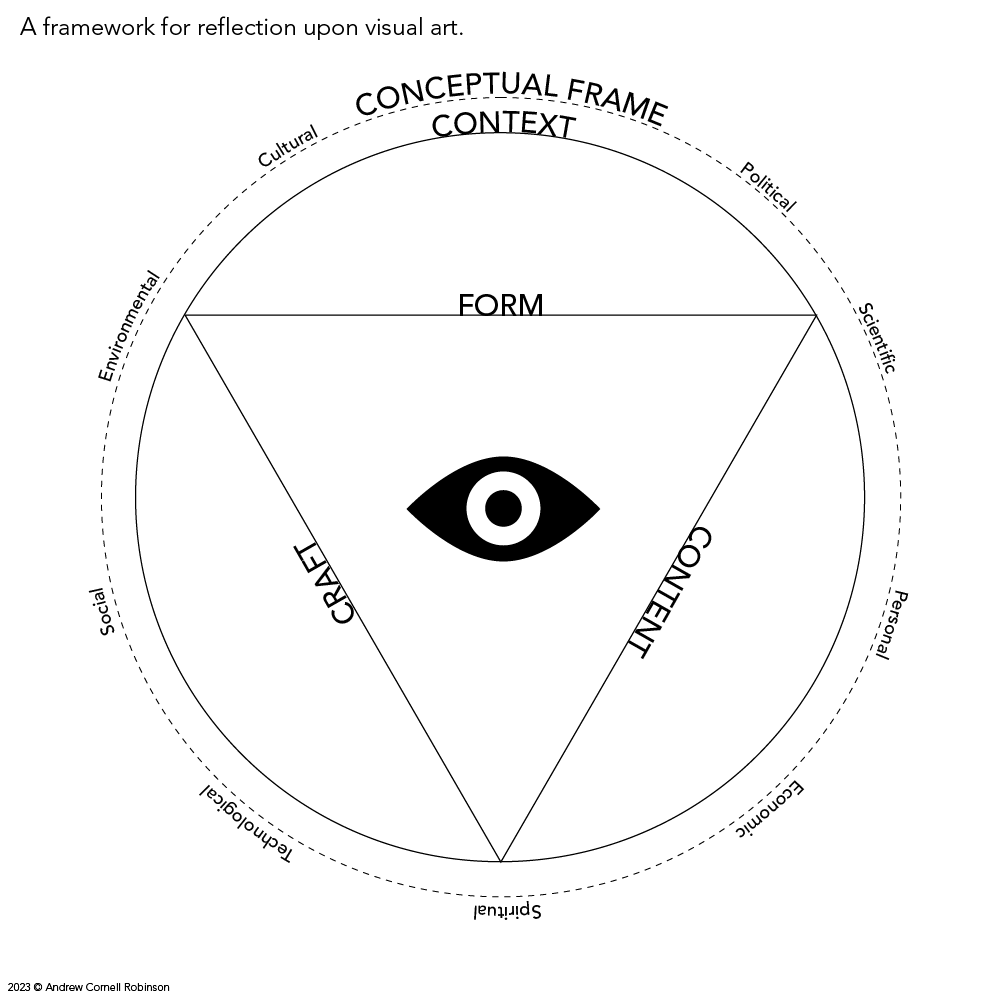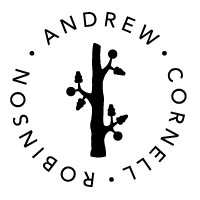As an artist and educator, I work to facilitate open and collaborative spaces where students can grow through problem-based learning strategies, which holistically explore making skills from multiple disciplines as well as conceptual strategies to help young artists and designers build confidence in their abilities, develop visual vocabularies, and articulate their lived experiences.
I typically begin a studio class with a discussion about looking and seeing. This leads us into a conversation about a rubric for our personal and collective reflections on the work we do in class together. Inviting the students to help define the rubric gives them a stake in the class framework. In variably this documentation takes the form of a diagram to help facilitate our discussions about the elements of art and design, and the objects and ideas that emerge from our work together. This framework is a loose outline of what has emerged over the years of teaching.

The framework functions like a window for reflecting upon our own creations and other works of art and design. The eye in the center represents both the object we observe. It is then viewed through a triangle of three over arching themes:
FORM What does it look like? How are the elements and principles of art and design used? eg. Gestalt, color, shape, rhythm, etc.
CRAFT How was it made? What tools, materials, and traditions were employed?
CONTENT What ideas are at play in the work? Did the creator have an intention? Was that intention understood by the viewer?
All of this is then viewed within a myriad of CONTEXTS that may impact how the work is perceived. This may be the context of the creator or viewers’ lived experiences. It may be viewed in the physical context, or its socio-political and cultural contexts, etc. Comprehension of ones craft (materials, discipline, techniques and skills) is equally important to gaining a clear comprehension of form (design, gestalt, point, line, plane, space, rhythm, movement, etc.) and designers and artists who are equipped with these tools also need to understand how to leverage them when exploring and conveying content (language, narrative, abstraction, etc.) and be aware of how all of these tools and ideas come together in a particular cultural context.
A CONCEPTUAL FRAME includes any number of themes brought to bear on the way we see; and think we understand what we are looking at. These themes may emerge out of the class discussion about the agreed upon rubric, or what is valued by the class cohort. The conceptual framework on the outer ring of the diagram is used to facilitate a discussion about how experience, context, craft, form and content help to form meaning. It is partly a discussion about semiotics but largely it is an opportunity to facilitate a dialogue about how meaning is formed by our lived experiences and perspectives. This entire framework helps to facilitate a discussion from multiple points of view.
For example, we might all be looking at an apple. How might we perceive that apple?

Through an art historical lens we might look precedents of the apple. Examples may include the Farnese Hercules sculpture holding three golden apples, referring to the ancient myth of Hercules’ eleventh labor. We might refer to the print Adam and Eve, by Albrecht Dürer illustrating the Christian myth of disobedience and forbidden fruit. Looking at Cezanne’s paintings of apples, and Rachel Harrison’s sculptures of apples interpreting Cézanne with fake fruit and sewing pins. Through an environmental lens, we might look at the origin of the apple which according to scientific research it comes from the central asian country of Kazakhstan. In the Americas we might then see it as a non-native species introduced through colonialism. This might open up a discussion about the history and politics of the apple. We might look at the economics of the apple? Who grows it? Who harvests them? How much are they paid? Who buys it? How come it is so cheap or expensive? We might look at it through a personal lens, such as through a memory of climbing in an apple tree as a child, or baking an apple pie, etc. What does the apple signify? These multiple windows of perception accommodate many voices and perspectives on the way we may see and understand. It also invites us to consider semiotics. Creating an opportunity for multiple interpretations facilitates a lively discussion. It also provides students and viewers alike with a coherent structure, giving them the confidence to consider what they value in a work of art. Accommodating a broad spectrum of ideas for discussion facilitates a diversity of approaches to learning and making.
In the end this approach to establishing an equal emphasis on craft, form, content and a consideration of context and understanding, reminds us of the complex ways that meaning is generated. As a counterpoint this is also an opportunity to introduce other ideas about art and criticism including “Against Interpretation” by Susan Sontag, etc. This framework for discussion can help students to practice ways of interrogating art works, and ideas. It is intended to expand the discussion to include more voices and perspectives on what is seen, understood, and valued.
While this framework is one that I have come to over many years of teaching and working in my studio, I owe a debt of gratitude to Dr. Sherman Merrill, assistant professor of history at Morgan State University, and the Maryland Institute College of Art, who inspired me as a student and laid the ground work for critical thinking in my art, politics, and life. In addition many other thinkers and ideas inform my own particular perspective on approaching critical discourse in the art studio, and the classroom. These include essays such as To Hell with Culture by Herbert Read, Invisible Dragons: Essays on Beauty by Dave Hickey, Teaching to Transgress: Education as the Practice of Freedom by Bell Hooks, the plays and novels of Jean Genet, the criticism and essays of Susan Sontag, and the poetry and power of example of Audre Lorde, among others.
Related Information
Leddy, Tom. “Against Surface Interpretation.” The Journal of Aesthetics and Art Criticism 57, no. 4 (1999): 459–63. https://doi.org/10.2307/432152.
Kuspit, Donald B. “Dewey’s Critique of Art for Art’s Sake.” The Journal of Aesthetics and Art Criticism 27, no. 1 (1968): 93–98. https://doi.org/10.2307/428533.
Sontag, Susan. “An Argument about Beauty.” Daedalus 134, no. 4 (2005): 208–13. http://www.jstor.org/stable/20028023.
Sontag, Susan. “Against Interpretation and Other Essays.” Picador, 2001
The basic tenant of semiotics, the theory of sign and sign-use, is antirealist. Human culture is made up of signs, each of which stands for something other than itself, and the people inhabiting culture busy themselves making sense of those signs. The core of semiotic theory is the definition of the factors involved in this permanent process of sign making and interpreting and the development of conceptual tools that help us to grasp that process as it goes on in various arenas of cultural activity. Art is one such arena, and it seems obvious that semiotics has something to contribute to the study of art.
Bal, Mieke, and Norman Bryson. “Semiotics and Art History.” The Art Bulletin 73, no. 2 (1991): 174–208. https://doi.org/10.2307/3045790.

